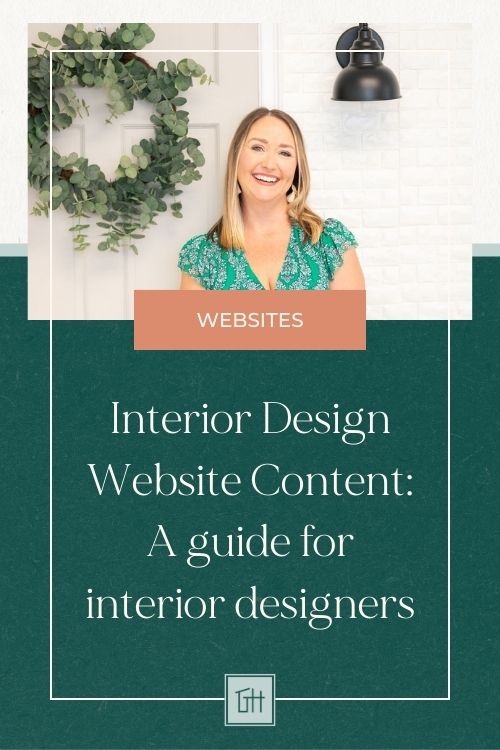As an interior designer, your website is a cornerstone of your brand identity and business strategy. It’s not just a portfolio—it’s a dynamic and powerful platform to engage clients, showcase your expertise, and build a compelling narrative around your work. Unfortunately, I see far too many interior designers wasting their money on pretty websites that don’t land new clients.
When my interior designer clients come to me, they’ve often looked to various big names in the industry for the best interior design website templates and inspiration. While I 100% agree that in a highly visual industry, website design style matters, the content on your interior design website—the words and images—matters much, much more.
In this post, we’re exploring the best approach to interior design website content. Whether you’re looking to touch up an existing website or start fresh, today, we’re going way beyond design inspiration. I’m here to help you make sure your website is working FOR you to GET CLIENTS.
Critical Interior Design Website Content
Interior Designer Website Home Page Template
Your homepage is your first impression. Within seconds, visitors should understand what you offer, who your services are for, and how they can start the process of working with you. Use a clear, engaging header and a direct call to action. This ensures your value proposition and unique services are front and center.
Here’s a rundown of the content I like to include on the homepage of my clients’ interior design websites:
- Hero Section: Use an attention-grabbing statement that captures the unique way your services are perfectly poised to meet to your client’s needs. Be as specific as possible!
- Pain + Dream + Fix Section: Include a short paragraph or bulleted list to describe what’s bothering your client. What are they struggling with, and what problems need solving? Follow it up by painting a picture of what they’re wishing for. What would progress look like? What do they aspire to achieve? Then, bring it all home by introducing YOU as the solution. Tell them all about the design services you offer to help them get what they want.
- Testimonial: Showcase your most compelling client testimonial.
- Intro Section: Introduce yourself or your brand. It’s okay to include a (very brief!) history or some of your credentials, but only if it helps position your brand as the expert the reader needs. Put yourself in the client’s shoes and ask yourself, “So what???” If it doesn’t contribute to their decision to hire you, cut it out. Keep this section concise and directly relevant to your client’s interest.
- Service Suite Section: Summarize two to four of your core interior design service offerings. For example, you could feature a one-hour paid consultation, an e-design package, and your full-service offer. Use a photo or some other visual to showcase each service and include a heading, description, and call to action for each one.
- Summary Section: This section is inspired by the StoryBrand framework, where we bring all of the above together in 1-3 paragraphs. This is a great podcast that gives a high-level overview of its key concepts.
Address each of the items below in a sentence or phrase in the order specified:
- Who do they want to be or be seen as? (Their aspirational identity.)
- What do they want as it relates to your product or service?
- What problem is holding them back?
- How does that problem make them feel?
- Why is it unfair that anyone should have to deal with this problem? (Take a stand here.)
- Express empathy. “We understand (fill in the blank).”
- Demonstrate why you’re qualified to solve the problem.
- Who do they want to be or be seen as? (Their aspirational identity.)
- Next Steps Section: This section sets expectations and tells the reader what comes next. Outline three to five steps to get started. This could be your inquiry process or more about the process you guide your clients through to deliver your interior design services.
- CTA: Include a final, direct call to action to book a discovery call or fill out your inquiry form. Tell them what to do in one to two sentences, followed by the last button on the page.
Interior Designer About Page
The About pages on the best interior design websites are much more than a biography. In fact, your about page isn’t really all that much about you at all. It’s about your client.
This is where you connect emotionally with site visitors. Explain not just who you are but why you do what you do—highlight your passion for interior design, your unique methodology, and what makes your design company unique. Again, ask yourself, “So what? What’s in it for me?” Your About page needs to answer this question from your client’s point of view. And it’s your opportunity to position yourself as the exact person they need to hire to get what they want.
Think of your About page as the beginning of a relationship. Talk to your readers … not at them. This is where the conversation begins.
Don’t forget to include high-quality, professional photos of yourself and your team to build trust and relatability.
Top Interior Design Services Page Content
Your Services Page should clearly spell out how you work with clients to deliver the outcome they want. My favorite way to structure these is to create a Services Summary page to give a high-level overview of each service offering and a separate, specific page to detail each individual service.
This approach gives you the best chance to get really targeted in your messaging for each service and communicate the detailed design process you use in various types of projects.
Use these pages to walk potential clients through the steps of working with you, from initial contact to project completion. If applicable, provide starting rates to manage expectations and filter prospective inquiries. Including FAQs on each service page can also be a big SEO booster!
A Successful Interior Design Contact Page
Make it oh-so-easy for clients to reach you or locate your design studio. Include a simple form or your direct contact information.
Better yet, integrate an online scheduling tool for consultations and put the power in the hands of your motivated future clients. It should be dead simple to get in touch and hire you. Eliminate as many barriers as possible here.
Including the right info on this page can also help with local SEO to drive traffic to your website. Most importantly, your name, address, and phone number need to appear exactly the same way they do in your Google Business Profile.
Additional Interior Design Website Content
Interior Design Portfolio Page
Are you surprised that I didn’t list your Portfolio page in the critical interior design website content section of this post? Most are.
This is one topic where I really take a stand. If you have professional-quality images of your design work, feel free to move this page to the critical category (even if you shot and edited them yourself).
That said, I think this one little nuance prevents sooo many new designers from creating a website at all.
Yes, I want you to showcase all of those beautiful room transformations, but if you’re just getting started, don’t let your design portfolio trip you up.
There is some special client out there who is ready to hire you based on your design philosophy, process, and winning personality alone.
So here’s your permission slip … it is ok to launch your website before you have an impressive portfolio. In fact, I would rather you start marketing your business with the pages above and wait until you can budget for the professional photographer before you begin adding portfolio photos to your website.
Once you’re ready, here are my best tips for maximizing the use of your design project images:
- Establish a long-term relationship with a photographer. A consistent style goes a long way. Invest in photography early and often, and don’t forget to include language in your design contract to ensure you have your client’s written permission to use photos of their space.
- Showcase only the projects you want to book more of. Your website does not need to feature every project. Omit photos that are not aligned with your ideal client. I promise there is no internet police comparing your portfolio website to your calendar looking for disapproving Ms. Fusspot’s project photos.
- Don’t exile your work to the Portfolio page. Sprinkle your beautiful design work throughout your whole website so that your website reflects the quality of your work. Think of this as subliminal messaging, artfully illustrating the outcome your clients are hoping for and guiding them to a decision.
- Tell the story of each project. This is an area where I wish we could get rid of the idea that “a picture is worth 1,000 words.” Every project can be a case study of the wildly talented, problem-solving interior designer that you are.
Combine images with stories that highlight the challenges of the project and your innovative solutions. Talk about your inspiration, how you helped your clients achieve their vision, how you helped them meet their specific lifestyle goals, and how you executed the project. This commentary goes a long way to building credibility with those readers who may be ready to hire a professional designer and make a much bigger impact on your SEO rankings than images alone.
Required Interior Design Website Content
These last few pages aren’t sexy, but they are legally required. I’d hate for you to overlook them, so they’re worth briefly mentioning.
Every website needs a privacy policy and terms of use. Many sites also need cookie policies and disclaimers.
I love Termageddon for this because it’s so simple. You complete a questionnaire about your business and website functionality, and they consistently monitor changing privacy laws. Your legal pages update auto-magically based on your answers, and they’ll send you alerts when new laws require you to update your policy questionnaire.
These are not just legal necessities; they also build trust by demonstrating professionalism and respect for user privacy.
Download the 10 Website Must-Haves for your Interior Design Business
Curious to learn all the key website features we put in place for our top interior design website clients? Grab our guide! This resource is packed with industry-specific tips and strategies to enhance your online presence and convert visitors into clients.







